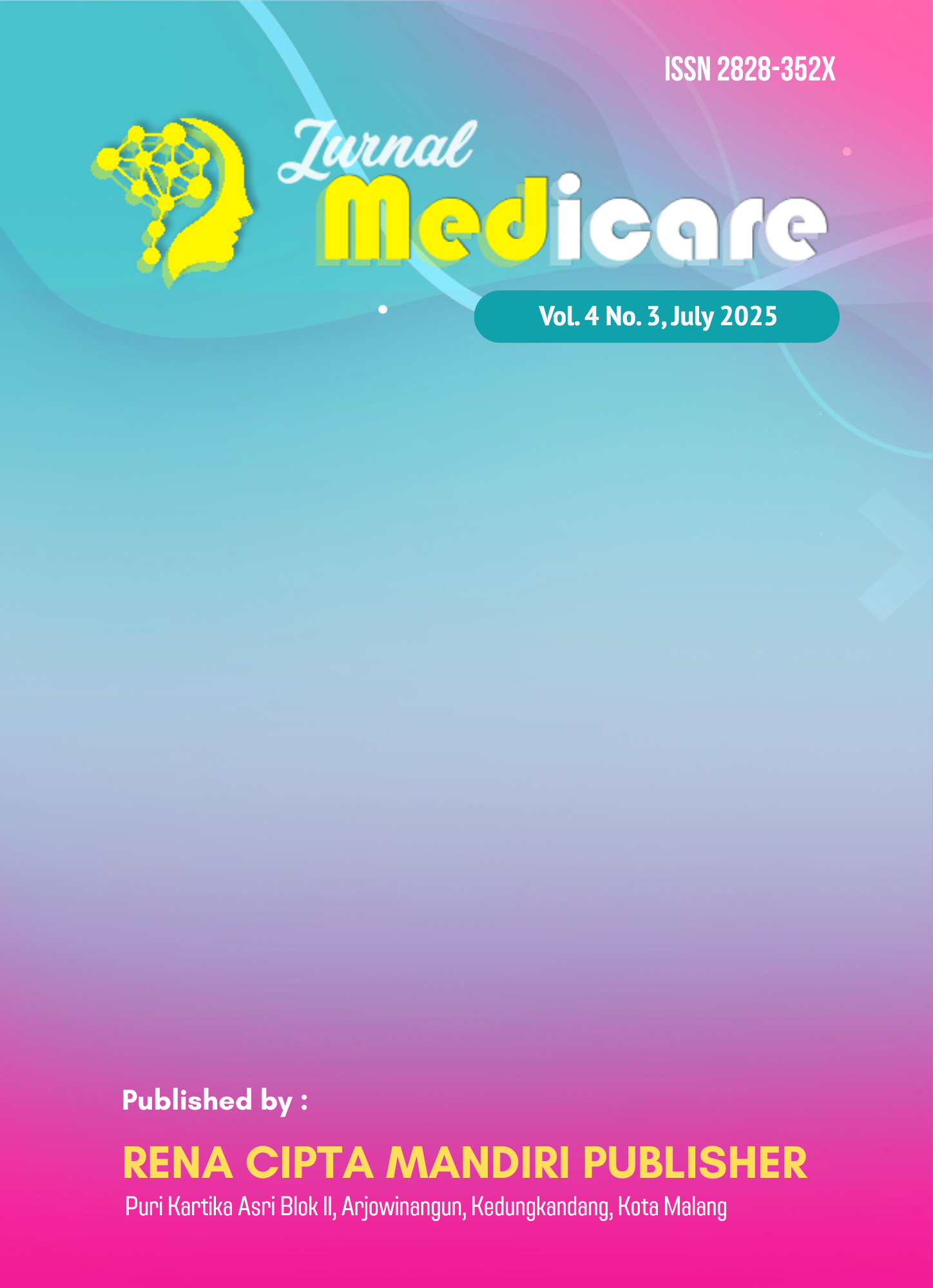PERAN PROBIOTIK DALAM MENGURANGI RESIKO BAKTERIAL VAGINOSIS DAN KETIDAKSUBURAN PADA WANITA USIA REPRODUKTIF
DOI:
https://doi.org/10.62354/jurnalmedicare.v4i3.215Keywords:
probiotics, bacterial vaginosis, infertility, vaginal microbiota, women's reproductive healthAbstract
This study examines the role of probiotics, especially Lactobacillus strains, in reducing the risk of bacterial vaginosis (BV) and infertility in women of reproductive age. BV occurs due to an imbalance in the vaginal microbiota, characterized by a decrease in Lactobacillus and an increase in pathogenic bacteria, which negatively impacts reproductive health. Probiotics help restore microbiota balance, lower vaginal pH, and protect against infection and inflammation. Findings indicate that probiotics can enhance treatment effectiveness, reduce recurrence, and potentially lower the risk of infertility. However, further research is needed to uncover molecular mechanisms and direct effects on fertility.
Downloads
References
Abavisani, M., Sahebi, S., Dadgar, F., & Peikfalak, F. (2024). Taiwanese Journal of Obstetrics & Gynecology The role of probiotics as adjunct treatment in the prevention and management of gynecological infections : An updated meta-analysis of 35 RCT studies. Taiwanese Journal of Obstetrics & Gynecology, 63(3), 357–368. https://doi.org/10.1016/j.tjog.2024.03.004
Abbe, C., & Mitchell, C. M. (2023). Approaches to treatment and prevention. May, 1–13. https://doi.org/10.3389/frph.2023.1100029
Alterations of Vaginal Microbiota in Women With Infertility and Chlamydia trachomatis Infection. 11(August), 1–11. https://doi.org/10.3389/fcimb.2021.698840
Amabebe, E., & Anumba, D. O. C. (2018). The Vaginal Microenvironment : The Physiologic Role of Lactobacilli. 5(June), 1–11. https://doi.org/10.3389/fmed.2018.00181
Argyri, K., Doulgeraki, A. I., Manthou, E., Grounta, A., Argyri, A. A., Nychas, G. E., & Tassou, C.
Argyri, K., Doulgeraki, A. I., Manthou, E., Grounta, A., Argyri, A. A., Nychas, G. J. E., & Tassou, C. C. (2020). Microbial diversity of fermented greek table olives of halkidiki and konservolia varieties from different regions as revealed by metagenomic analysis. Microorganisms, 8(8), 1241.
Chen, H., Wang, L., Zhao, L., Luo, L., Min, S., Wen, Y., Lei, W., Shu, M., & Li, Z. (2021).
Chen, X., Lu, Y., Chen, T., & Li, R. (2021). The Female Vaginal Microbiome in Health and Bacterial Vaginosis. 11(April), 1–15. https://doi.org/10.3389/fcimb.2021.631972
Delden, C. Van, Stampf, S., Hirsch, H. H., Manuel, O., Meylan, P., Cusini, A., Hirzel, C., Khanna, N., Weisser, M., Garzoni, C., Boggian, K., Berger, C., Nadal, D., Koller, M., Saccilotto, R., & Mueller, N. J. (2020). Burden and Timeline of Infectious Diseases in the First Year After Solid Organ Transplantation in the Swiss Transplant Cohort Study. 71, 4–6. https://doi.org/10.1093/cid/ciz1113
Fan, Y., Gu, Y., Xian, Y., Li, Q., He, Y., Chen, K., Yu, H., Deng, H., Xiong, L., Cui, Z., Yang, Y., & Xiang, Y. (2024). Ef fi cacy and safety of different drugs for the treatment of bacterial vaginosis : a systematic review and network. October, 1–13. https://doi.org/10.3389/fcimb.2024.1402346
Joseph, R. J., Ser, H., Kuai, Y., Tan, L. T., Jayanthi, V., Arasoo, T., Letchumanan, V., Wang, L., Pusparajah, P., Goh, B., Mutalib, N. A., Chan, K., & Lee, L. (2021). Finding a Balance in the Vaginal Microbiome : How Do We Treat and Prevent the Occurrence of Bacterial Vaginosis ? 1–39.
Lin, T. C., Hsu, I. L., Tsai, W. H., Chu, Y. C., Kuan, L. C., Huang, M. S., ... & Chang, W. W. (2021). Improvement of bacterial vaginosis by oral lactobacillus supplement: A randomized, double-blinded trial. Applied Sciences, 11(3), 902.
Mashatan, N., & Heidari, R. (2023). Probiotics in vaginal health Probiotics in vaginal health. June. https://doi.org/10.1093/femspd/ftad012
Murris, F., Huchon, C., Zilberman, S., Phalippou, J., Canlorbe, G., Ballester, M., Gauthier, T., Avigdor, S., Rua, C., Legendre, G., Darai, E., & Ouldamer, L. (2021). Journal of Gynecology Obstetrics and Human Reproduction Impact of the first lockdown for coronavirus 19 on breast cancer management in France : A multicentre survey. Journal of Gynecology Obstetrics and Human Reproduction, 50(9), 102166. https://doi.org/10.1016/j.jogoh.2021.102166
Muzny, C. A., & Sobel, J. D. (2023). Understanding and preventing recurring bacterial vaginosis: Important considerations for clinicians. International journal of women's health, 1317-1325.
Parolin, C., Marangoni, A., Laghi, L., Foschi, C., Palomino, A. Ñ., Calonghi, N., Cevenini, R., & Vitali, B. (2015). Isolation of Vaginal Lactobacilli and Characterization of Anti- Candida Activity. 1–17. https://doi.org/10.1371/journal.pone.0131220
Ravel, J., Moreno, I., & Simón, C. (2021). Expert Reviews Bacterial vaginosis and its association with infertility , endometritis , and pelvic. The American Journal of Obstetrics & Gynecology, 224(3), 251–257. https://doi.org/10.1016/j.ajog.2020.10.019
Schwecht, I., Nazli, A., Gill, B., & Kaushic, C. (2023). Lactic acid enhances vaginal epithelial barrier integrity and ameliorates inflammatory effects of dysbiotic short chain fatty acids and HIV ‑ 1. Scientific Reports, 0123456789, 1–16. https://doi.org/10.1038/s41598-023-47172-y
Sudarsana, P., Suardana, K., Agung, I. G., Puspitayani, M., & Kadek, N. L. (2022). BAKTERIAL VAGINOSIS : ETIOLOGI , DIAGNOSIS , DAN TATALAKSANA. 2(2), 110–114.
Tachedjian, G., Hanlon, D. E. O., & Ravel, J. (2018). The implausible “ in vivo ” role of hydrogen peroxide as an antimicrobial factor produced by vaginal microbiota. 3–7.
Tomusiak, A., Strus, M., & Heczko, P. B. (2015). Efficacy and safety of a vaginal medicinal product containing three strains of probiotic bacteria : a multicenter , randomized , double- blind , and. 5345–5354.
Udjianto, U., Sirat, N. A., & Rahardjo, B. (2025). narra j vaginosis treatment and recurrence. 1– 17.
Ughade, P. A., Shrivastava, D., & Chaudhari, K. (2024). Navigating the Microbial Landscape : Understanding Dysbiosis in Human Genital Tracts and Its Impact on Fertility. 16(8). https://doi.org/10.7759/cureus.67040
Ma, X., Wang, X., Ye, S., Liu, J., Yuan, H., & Wang, N. (2022). Biofilm and pathogenic factor analysis of Gardnerella vaginalis associated with bacterial vaginosis in Northeast China. Frontiers in Microbiology, 13, 1033040.
Downloads
Published
How to Cite
Issue
Section
License
Copyright (c) 2025 Jurnal Medicare

This work is licensed under a Creative Commons Attribution-ShareAlike 4.0 International License.
Licensing for Data Publication
-
Open Data Commons Attribution License, http://www.opendatacommons.org/licenses/by/1.0/ (default)
-
Creative Commons CC-Zero Waiver, http://creativecommons.org/publicdomain/zero/1.0/
-
Open Data Commons Public Domain Dedication and Licence, http://www.opendatacommons.org/licenses/pddl/1-0/


















